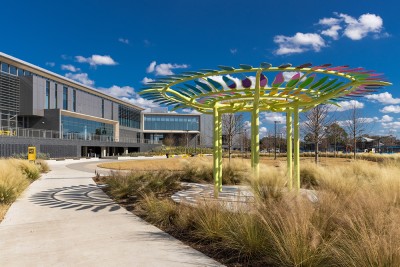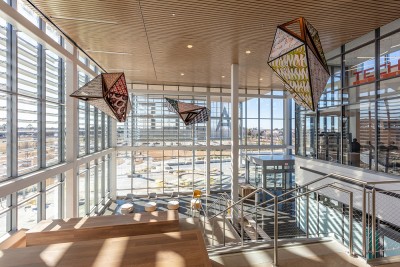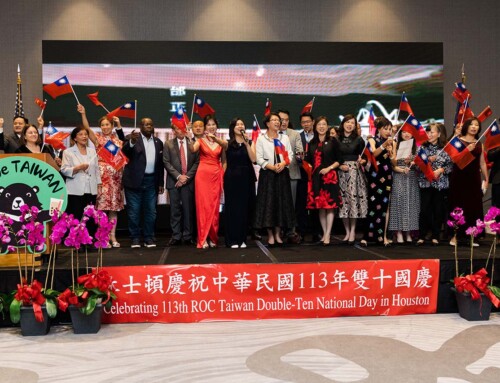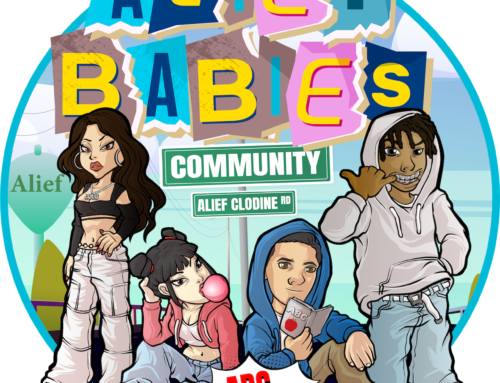
Windbloom
In 1917, a tiny farming settlement called Dairy was renamed Alief in honor of Alief Ozelda Morris Magee, one of the area’s first settlers. She had served as its first postmaster.
Today the legacies of Alief the female pioneer and Alief the community are crystallized symbolically — along with the area’s history, diversity and native environment — in three large-scale art installations in the new $54 million Alief Neighborhood Center and Park at 11903 Bellaire Boulevard.
The art commissions, a point of pride of the center, were fulfilled by a group of local women artists. The works add a unique cultural flair to the city’s public art scene.
The three artworks – two indoor and one outdoor – are among the latest prized additions to the city’s Civic Art Collection, which started in 2020 as an equity project to support civic art from all of its communities. The new works were selected from among submissions by 76 artists.
“While we weren’t pursuing commissions exclusively from woman artists of color; it just so happened that the woman artists of color who proposed these concepts did so with tremendous sensitivity to the community,” said Theresa Escobedo, the city’s civic art program manager..
At the main entrance of the Alief center, one is greeted by “Folding Stories,” a group of three polyhedral, multifaceted sculptures suspended from the atrium ceiling. Created by the Red Thread Collective — an artist trio of South Asian descent including Sneha Bhavsar, Rakhee Jain Desai and Ami Mehta — the artworks use hand-painted, culturally inspired textile.
At the east atrium, a cloud of fluttering butterflies in shades of lavender, blue, orange and green floats from the ceiling. With a sense of buoyancy and movement, it journeys along the hallway towards the door facing an outdoor butterfly garden.
Dubbed “Alief Swarm,” the artwork by the Filipina American artist Bennie Flores Ansell glistens with creativity. A closer look reveals the wings to be cutouts of shoe images.

Alief Swarm
In the butterfly garden across from the front porch, interdisciplinary artist and landscape architect Falon Mihalic sculpted “Windbloom,” an umbrella-like structure with components shaped like flower petals and plant stems.
Connoting a sense of the artist’s nostalgia for a bygone native ecological condition of the area, the overhead sculpture supported by columns represents a map of the prevailing winds at what used to be known as an open coastal prairie, Mihalic said.
In vibrant colors, the art installation is meant to be appreciated up close from underneath as a shading canopy. It offers a nature-inspired, meditative oasis just a stone’s throw away from the hustle and bustle of Bellaire Boulevard.
Front and center in the artists’ creative processes were conscious efforts to engage Alief residents.
After stumbling on the shoe image laser cuts’ likeness to butterflies, Ansell decided to marry the two – both symbolizing movement – in her art project to tell the story of the immigrants coming to make Alief their home and join hands to build their community.
The project is an apt message “in terms of people migrating from other places to live here, being a swarm and working together to pursue a common goal,” she said.
Ansell took pictures of shoe models and enlisted community groups, including Alief Middle School pupils, to help her pick out the ones that they believe define the Alief community. Five models were selected to create the 1,000-butterfly swarm using laser-cut, printed dichroic Plexiglass.
“I wanted to share the project with them. I wanted them to go back and see (the artwork) and say, ‘I was part of that; I helped choose those,’” she said. “It’s very important that they have a voice. I hope the Alief community sees themselves reflected in the piece.”

Folding Stories
In the “Folding Stories” project, the artist trio said the textiles serve as a visual narrative of Alief’s journey to becoming one of the most ethnically diverse neighborhoods in the U.S.
They engaged art students from Alief Independent School District’s early college program to contribute design ideas influenced by their cultural backgrounds.
The trio also recruited a group of immigrant women for the embroidery work incorporating the quilting and stitching traditions of their ancestral homelands.
“Community engagement should always be integral to the development of the idea of any civic art,” said Desai of the Red Thread Collective. “If the community sees the piece representing them, they’ll have a sense of ownership…We hope that people will see the artworks are a true embodiment of the Alief community.”
The legendary postmaster named Alief inspired the trio’s effort to collect hand-written letters from Alief residents and superimpose letter excerpts on the fabric sides of the sculptures. The artworks resemble folded letters, adding another element to honor Alief’s history, Bhavsar said.
“I want (people) to see this piece every day and remind themselves that it’s a celebration for the community that they built,” Desai said.
— by Zen Zheng







Leave A Comment